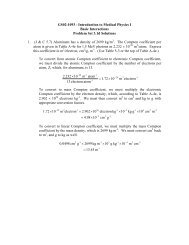link to lecture transcript - UT-H GSBS Medical Physics Class Site
link to lecture transcript - UT-H GSBS Medical Physics Class Site
link to lecture transcript - UT-H GSBS Medical Physics Class Site
Create successful ePaper yourself
Turn your PDF publications into a flip-book with our unique Google optimized e-Paper software.
We now have the differential scatter cross section. The energy interval we’re<br />
looking at from 0.15 <strong>to</strong> 0.25 MeV is 0.1 MeV. To obtain the cross section we<br />
integrate the differential cross section over the energy interval. Assuming the<br />
differential cross section is constant over that energy interval, a reasonable<br />
assumption, we find the cross section is 7 10-30 meters squared per electron. To<br />
calculate the number of electrons generated in this energy range we multiply the<br />
number of incident pho<strong>to</strong>ns, 104 , times the cross section, 7 10-30 meters squared<br />
per electron times the absorber thickness 3 16 1027 per electron, times the absorber thickness, 3.16 10 electrons per meter squared squared,<br />
giving us an answer of 220 electrons.<br />
In general when we want <strong>to</strong> calculate the number of electrons that are liberated, we<br />
take the differential energy cross section, multiply it by the energy interval, multiply<br />
it by the number of incident pho<strong>to</strong>ns, multiply that by the electron density. The cross<br />
section section, then then, is the probability of an interaction per unit incident pho<strong>to</strong>n fluence. fluence<br />
Is everyone comfortable with this kind of a calculation? The problem sets will give<br />
you more practice in doing calculations of this nature. Our basic goal in doing these<br />
problems is <strong>to</strong> be able <strong>to</strong> know where the energy is going. Remember, we need <strong>to</strong><br />
follow the energy.<br />
34





